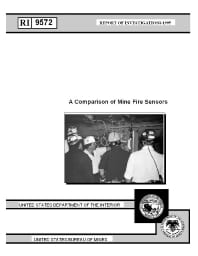Mining Publication: A Comparison of Mine Fire Sensors
Original creation date: January 1995
Authors: RS Conti, CD Litton
NIOSHTIC2 Number: 20022706
Pittsburgh, PA: U.S. Department of the Interior, Bureau of Mines, RI 9572, 1995 Jan; :1-10
This U.S. Bureau of Mines (USBM) report discusses the results of research conducted in the USBM experimental mine at its Lake Lynn Laboratory to determine the alarm times of smoke and carbon monoxide (CO) sensors, and a point type heat sensor (PTHS) to slowly developing coal-conveyor belt fires. The tests were conducted at air velocities of 0.44 and 0.97 m/s. The data clearly indicate that smoke sensors provide earlier warning of fire than 10 ppm CO sensors, and that 10 ppm CO sensors provide earlier warning than PTHS. A success rate of 1.0 (indicating detection of every test fire) was obtained for both smoke and CO sensors. For the PTHS, the success rate was 0.57 at the lower air velocity, decreasing to 0 at the higher air velocity. Data are also presented showing the sequence of fire events and detection events at the two air velocities as a function of time. Results show that early detection and warning of underground mine fires will improve the probability of miners' escape.

NIOSHTIC2 Number: 20022706
Pittsburgh, PA: U.S. Department of the Interior, Bureau of Mines, RI 9572, 1995 Jan; :1-10